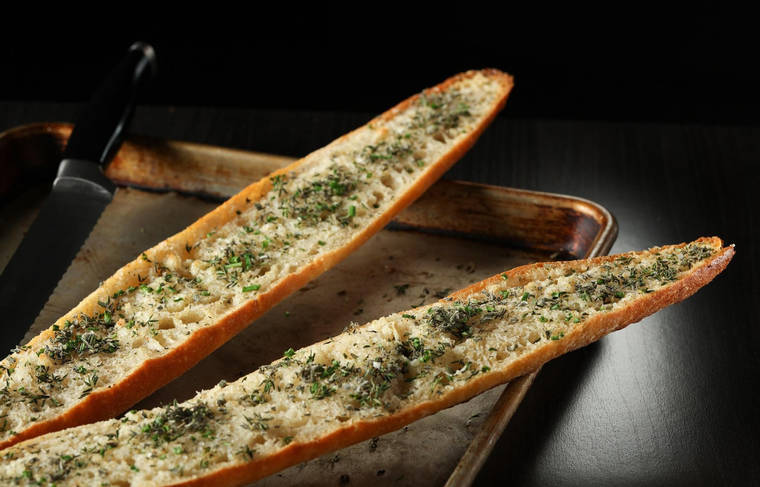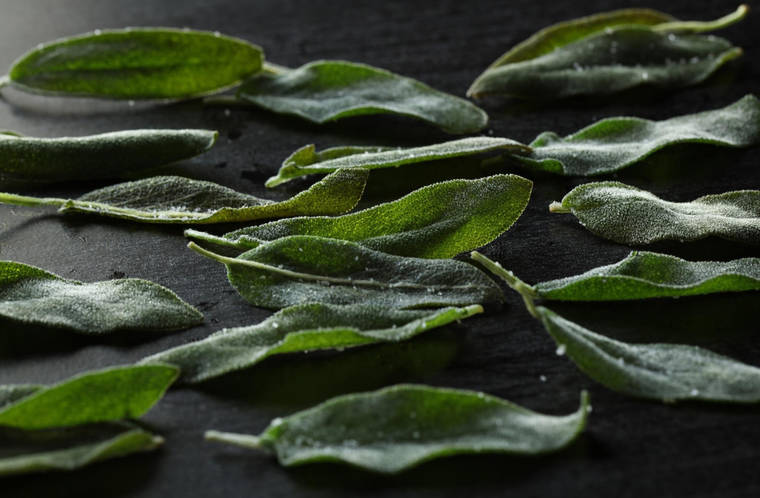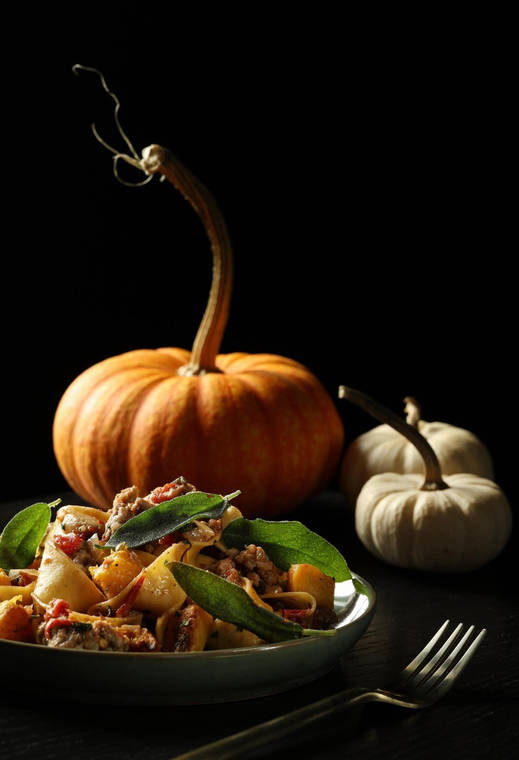Keep celebrating with pasta dinner with pumpkin, sage and sausage



This season puts me in panic mode: What to cook now?
This season puts me in panic mode: What to cook now?
In the Midwest, we feel blessed if the garden’s basil, cilantro, mint and dill remain bright and green until October. Late in the month, fresh sage, thyme, parsley and perhaps chives are all my garden offers to enhance my cooking and cravings for flavor. Fortunately, these decidedly fall herbs pair well with other fall offerings such as pumpkin, winter squash and hearty greens.
Now is the time to stock up on sugar pumpkins, aka pie pumpkins, and other gorgeous varieties. Decorate with them, yes, but be sure to cook them into soup and stews throughout the season. Indeed, the pale, blueish-green flat pumpkins, the bright orange lakotas, the oddly shaped turbans and the small “sweet lightening” squash taste as good as they are attractive. In fact, I like eating all pumpkins with the exception of the large specimens best for Halloween carving.
Peeled, diced and roasted, pumpkin and other winter squashes make a fantastically delicious side dish to roast pork and poultry. Of course, I clean, rinse and salt the pumpkin seeds to slow roast for a snack.
How much pumpkin to buy for cooking? Know that small to medium-size pumpkins and winter squash yield about 1 cup peeled, diced flesh per pound. In other words, a 3-pound pie pumpkin will give you 3 cups of cubes ready for roasting. The skin is not edible no matter how you cook these hard winter squashes. A vegetable peeler rarely works; you’ll need a sharp knife and a bit of patience.
The taste and texture of freshly peeled pumpkin (or ranut squash) is worth the effort to me — when I have the time. For a quick weeknight supper, I confess to using peeled and diced butternut squash sold in bags in the produce section. Just know that some texture will be sacrificed as the prepped vegetable tends to be soggier.
My fall celebration meal pairs roasted pumpkin with a quick sausage ragu with a topping of fried sage leaves served over pappardelle pasta. You can also use wide egg noodles here; just be sure to use a brand made with egg yolks for the deep yellow color — a nice contrast to the pumpkin.
For the sausage in the ragu, I like the chub of sage-infused pork sausage sold in the breakfast meat section of the grocery store — near the bacon. Alternatively, use mild or hot Italian sausage without casings. When I’m watching my fat intake, I substitute ground turkey and add a double-dose of the poultry seasoning for added flavor. My favorite version uses fresh venison sausage brought to me by a loving cousin.
Serve the pasta dish with a wedge of baby romaine topped with a fresh lemon dressing. Crusty garlic bread is always a treat.
Armed with ideas to celebrate fall flavors, I’m ready for the ghosts and goblins to show up. Just ring the doorbell, please. No panic needed here.
Fall celebration menu
Pumpkin, sausage and sage ragu over pappardelle pasta
Baby romaine wedge salad with creamy lemon dressing
Crusty garlic bread with herbs
Pumpkin ice cream and cookies
Sparkling cider
Pumpkin, Sausage and Sage Ragu over Pappardelle
Prep: 25 minutes
Cook: 25 minutes
Makes: 4 servings
You can use diced butternut squash from the produce department to save time. Bottled poultry seasoning tastes like fall; it’s usually made from thyme, sage, marjoram, rosemary, black pepper and nutmeg.
2 to 3 generous cups diced peeled fresh pumpkin or butternut squash, 12 to 16 ounces
1 1/2 tablespoons olive oil
1/2 teaspoon salt
1 pound bulk pork sausage with sage, or bulk mild or hot Italian sausage
1/2 large white onion, diced
1 cup diced mushrooms
1 can (15 ounces) diced tomatoes with juices
2 large cloves garlic, crushed
1/2 teaspoon poultry seasoning
Salt, freshly ground pepper
1 package (8.8 ounces) egg pappardelle or tagliatelle pasta (or egg noodles)
2 tablespoons chopped fresh parsley or chives
1 tablespoon very finely sliced fresh sage leaves
2 tablespoons sage oil, see recipe, optional
Fried sage leaves, see recipe
Shredded Parmesan
1. Heat oven to 450 degrees. Toss pumpkin cubes with olive oil. Sprinkle with salt. Roast on a rimmed baking sheet, stirring once or twice, until tender and golden, about 15 minutes. Remove from oven. (Refrigerate covered up to several days; reheat before using.)
2. Meanwhile, put sausage, onion and mushrooms in large nonstick skillet. Cook over medium-high heat (use a splatter guard) stirring and chopping up the sausage with a spatula until meat is thoroughly cooked and golden, about 10 minutes.
3. Stir in tomatoes, garlic and poultry seasoning. Cook over medium heat, stirring often, until thickened, about 10 minutes. Taste and season with salt and pepper. (Mixture can be made up to 2 days in advance; refrigerate covered and reheat before using.)
4. Heat a large kettle of generously salted water over high heat to boil. Add the pasta. Cook, stirring often, until al dente, 5 to 7 minutes. Drain the pasta.
5. Add drained pasta to the skillet with the meat. Toss to coat. Add the roasted pumpkin, parsley, fresh sage leaves and sage oil if using. Toss.
6. Serve garnished with fried sage leaves. Pass the Parmesan.
Sage Oil and Fried Leaves
Prep: 5 minutes
Cook: 2 minutes
Makes: about 1/3 cup
1/3 cup expeller-pressed canola oil, safflower oil or sunflower oil
15 to 20 large sage leaves, patted dry
Coarse salt
1. Heat oil in a small, deep skillet set over medium heat until the edge of a sage leaf sizzles when inserted into the oil. Add 5 sage leaves and turn with a fork (watch for sputtering oil) until dark green but not brown, 30 to 60 seconds. Drain on a paper toweling. Repeat to fry all the leaves making sure oil never gets too hot.
2. Use the sage leaves while still warm. Reserve the oil for use later with pasta or in salads.
Creamy Lemon Salad Dressing with Fresh Thyme and Honey
Prep: 10 minutes
Makes: about 1 cup
This tangy dressing tastes delicious over hearty salad greens such as baby kale, endive and wedges of baby romaine. Diced tomato or roasted red bell pepper bits complement the dressing nicely.
1 large or 2 small lemons
1/4 cup extra-virgin olive oil
2 tablespoons canola or vegetable oil
2 tablespoons mayonnaise
1 clove garlic, crushed
1/2 teaspoon salt
1/2 teaspoon each, finely chopped fresh thyme and fresh sage leaves (or 1/4 teaspoon each dried)
1/4 teaspoon freshly ground black pepper
1 to 2 teaspoons honey
1. Use a rasp grater to grate lemon zest into a small bowl. You’ll need about 1 teaspoon zest (but no white pith or the dressing will be bitter).
2. Cut the lemon in half and squeeze the juice into the bowl. You should have just about 1/4 cup. Add the oils, mayonnaise, garlic, salt, herbs and pepper. Whisk to mix well. Add 1 teaspoon honey. Whisk again and taste. Adjust the seasoning with more honey or salt if desired.
Crusty Garlic Bread with Herbs
Prep: 10 minutes
Bake: 12 minutes
Makes: 6 servings
I confess to a fondness for Lawry’s Garlic Salt with Parsley for speedy garlic bread. Use a par-baked loaf (also called take-and-bake) from the supermarket, found in the bakery or freezer case.
1 baguette loaf (about 14 ounces) take-and-bake bread
1/2 stick (1/4 cup) unsalted butter, softened
Garlic salt with parsley, to taste
2 tablespoons chopped fresh herbs, such as a combination of sage, thyme, chives, oregano
1. Heat oven to 375 degrees. Slice bread horizontally in half and place cut side up on a baking sheet.
2. Smear butter over both bread halves. Sprinkle generously with garlic salt. Bake until edges of bread are crusty, about 10 minutes. Sprinkle with herbs. Bake 1 or 2 minutes more. Serve warm.


